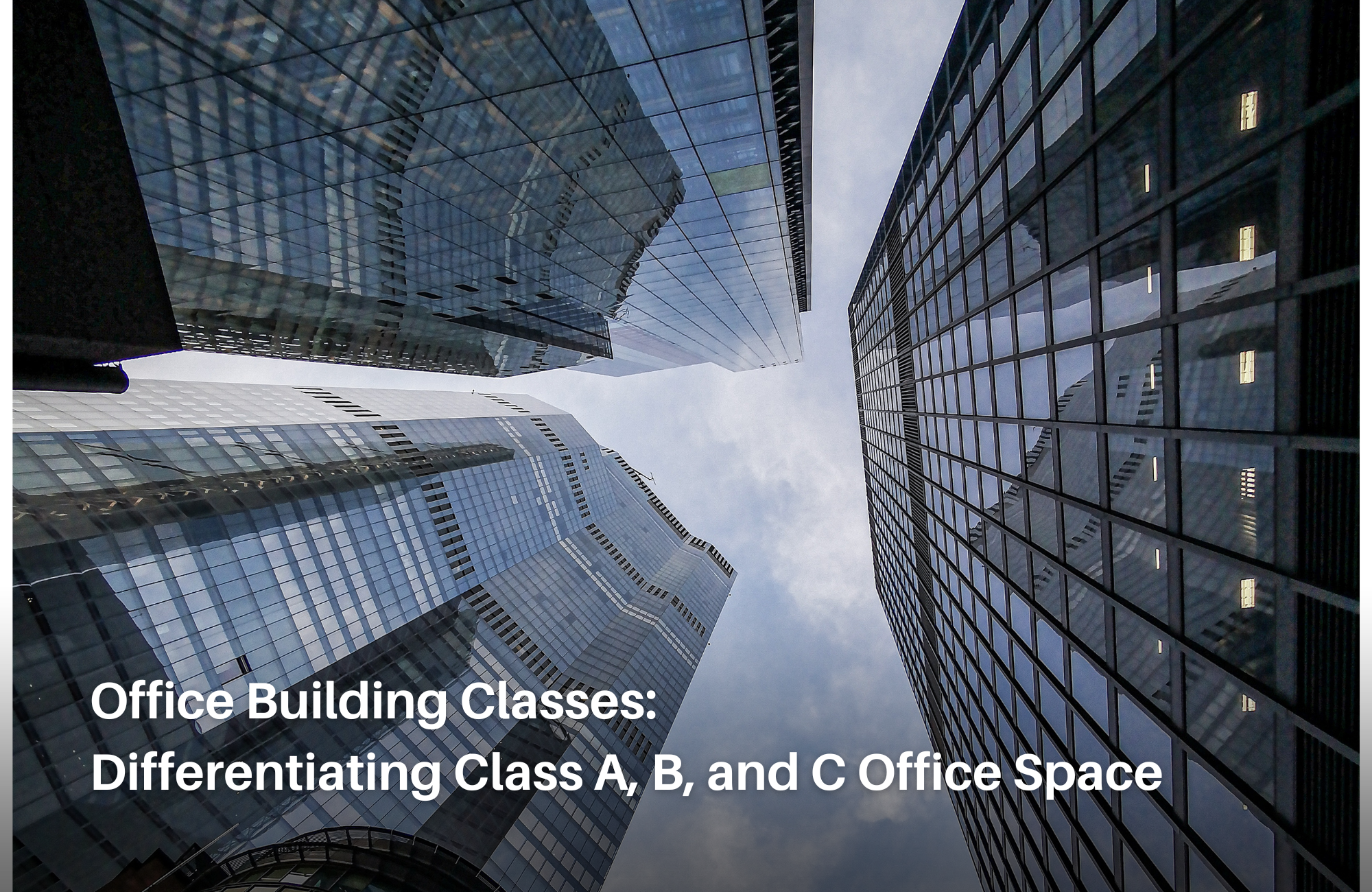
Office Building Classification: How to Choose the Right Workspace for Your Business
When searching for office space, potential tenants often come across terms like “Class A,” “Class B,” and “Class C” office buildings. These classifications help differentiate office spaces based on their quality, location, amenities, and price. Understanding these distinctions is crucial for businesses, whether they are startups, small enterprises, or large corporations, to make an informed decision that aligns with their needs and budget.
In this story
In this guide, we will explore:
- What office building classification means.
- Why office classification is necessary.
- The key characteristics of Class A, B, and C office buildings.
- How to choose the right office class based on your business requirements.
By the end of this article, you will have a clear understanding of office classifications and be better equipped to select the right space for your company.
What is Office Building Classification?
Office building classification is a system used to categorize office spaces based on their overall quality, location, amenities, and infrastructure. It serves as a standardized way for real estate professionals, investors, and tenants to assess and compare different office buildings.
The most commonly used classification system consists of three main categories:
- Class A – Premium-grade office buildings with top-tier amenities and infrastructure.
- Class B – Mid-tier office buildings that offer a balance between cost and quality.
- Class C – Budget-friendly office spaces with basic facilities and fewer amenities.
Each classification provides a general guideline, but the exact criteria may vary by location and real estate market trends.
Why is Office Classification Necessary?
Office classification is important for several reasons:
- Helps Tenants Make Informed Decisions – Businesses can assess whether an office space aligns with their operational needs, brand image, and budget.
- Guides Real Estate Investments – Investors and property developers use these classifications to evaluate market demand and property value.
- Standardizes Market Comparisons – Tenants and property owners can easily compare office spaces based on predefined criteria.
- Influences Rental Pricing – The classification affects rental rates, lease terms, and property desirability.
- Impacts Employee Productivity & Business Reputation – The quality of office space can affect employee satisfaction, productivity, and how a company is perceived by clients and partners.
Now, let’s explore each office class in detail.
Class A Offices
Definition: What is a Class A Office?
Class A offices represent the highest standard in commercial real estate. These buildings offer modern architecture, advanced infrastructure, and premium services. They are often located in prestigious business districts and cater to high-profile tenants.
Characteristics of Class A Offices
- Location
- Situated in prime city areas or central business districts (CBDs).
- Excellent transport accessibility with nearby metro stations, major roads, and public transit hubs.
- Surrounded by high-end businesses, restaurants, and luxury accommodations.
- Architecture and Design
- Modern and aesthetically impressive exterior and interior design.
- Constructed using high-quality materials such as glass facades, steel structures, and premium finishes.
- Spacious, well-lit offices with ergonomic layouts.
- Engineering Systems
- Advanced heating, ventilation, and air conditioning (HVAC) systems for optimal indoor comfort.
- Smart lighting, energy-efficient technologies, and high-speed internet connectivity.
- High-security systems, including access control, surveillance cameras, and on-site security personnel.
- Amenities
- On-site restaurants, cafés, fitness centers, and conference rooms.
- High-end lobbies with professional reception and concierge services.
- Sufficient parking spaces, sometimes including valet services or electric vehicle charging stations.
- Building Management
- Professionally managed properties with 24/7 maintenance services.
- Efficient property management teams handling cleaning, security, and technical support.
- Compliance with sustainability and energy efficiency standards.
Advantages of Class A Offices
✅ Prestige and high brand reputation.
✅ Modern infrastructure and comfortable working conditions.
✅ Convenient location with excellent business networking opportunities.
✅ High-quality amenities that enhance employee satisfaction.
Disadvantages of Class A Offices
❌ High rental costs.
❌ Competitive leasing market, often requiring long-term commitments.
❌ Higher service charges for maintenance and amenities.
Target Audience
- Large multinational corporations.
- Financial institutions, banks, and investment firms.
- Law firms, consulting agencies, and tech enterprises.
- Luxury brands and businesses focused on high-end clientele.
Class B Offices
Definition: What is a Class B Office?
Class B offices are a step below Class A in terms of prestige, design, and amenities, but they still offer a solid and functional workspace. These buildings are often found in less central but still desirable locations and provide a good balance between quality and cost.
Characteristics of Class B Offices
- Location
- Typically located in business districts near city centers or in well-connected suburban areas.
- Good transport accessibility, with proximity to highways, metro stations, or bus routes.
- Often found in developing business areas where new infrastructure is emerging.
- Architecture and Design
- Can be either modern or slightly older buildings that have been renovated.
- Decent interior finishes, though not as luxurious as Class A.
- Functional office layouts with moderate customization options.
- Engineering Systems
- Standard heating, ventilation, and air conditioning (HVAC) systems, but may not be as advanced as in Class A buildings.
- Reliable electrical, plumbing, and internet connectivity, though upgrades may be needed in some cases.
- Security systems are present but might not include high-end surveillance or biometric access.
- Amenities
- Some Class B buildings have on-site cafés, parking, and shared meeting rooms.
- Fitness centers and dining options may be available but are not as premium as in Class A offices.
- Fewer high-end features like concierge services or luxury lobbies.
- Building Management
- Professional property management, though services might not be as extensive as in Class A offices.
- Regular maintenance and cleaning, but response times for repairs might be slower.
- Moderate adherence to sustainability and energy efficiency standards.
Advantages of Class B Offices
✅ More affordable than Class A offices while still offering good facilities.
✅ Decent location with access to transportation and business districts.
✅ Suitable for growing companies looking for a professional environment.
✅ Often available for shorter lease terms compared to Class A buildings.
Disadvantages of Class B Offices
❌ Less prestigious location and design compared to Class A.
❌ Older buildings may have outdated infrastructure.
❌ Fewer amenities and services compared to premium offices.
Target Audience
- Small and medium-sized businesses looking for cost-effective office space.
- Startups transitioning from coworking spaces to a private office.
- Independent professionals, freelancers, and growing companies.
- Businesses that prioritize functionality over high-end prestige.
Class C Offices
Definition: What is a Class C Office?
Class C offices offer basic and affordable workspaces. These buildings are typically older, located in less desirable areas, and have minimal amenities. They are ideal for businesses looking for the lowest-cost rental options.
Characteristics of Class C Offices
- Location
- Often located in industrial zones, outskirts of cities, or less commercially developed areas.
- Limited access to public transportation and major highways.
- Surroundings may include warehouses, factories, or low-cost residential buildings.
- Architecture and Design
- Older buildings, possibly dating back several decades, with minimal renovation.
- Basic office interiors with standard finishes.
- Functional but outdated layouts, often lacking modern open-space designs.
- Engineering Systems
- HVAC, plumbing, and electrical systems may be outdated or require frequent maintenance.
- Internet and telecommunication infrastructure may not support high-speed requirements.
- Security systems may be minimal, sometimes relying on standard locks and keys instead of electronic access.
- Amenities
- Limited or no on-site amenities like cafés, parking, or fitness centers.
- Shared restrooms and break areas may be outdated.
- Few or no conference rooms, forcing tenants to seek external venues for meetings.
- Building Management
- Minimal professional management, with basic maintenance services.
- Some buildings may require tenants to handle repairs themselves.
- Low compliance with sustainability and energy efficiency standards.
Advantages of Class C Offices
✅ Lowest rental cost, making it ideal for businesses with tight budgets.
✅ Suitable for companies that do not require a prestigious address.
✅ Often flexible lease terms, allowing for shorter commitments.
Disadvantages of Class C Offices
❌ Older infrastructure, leading to potential maintenance issues.
❌ Limited amenities and uncomfortable work environments.
❌ Inconvenient locations that may impact employee accessibility and client visits.
Target Audience
- Startups and small businesses with limited financial resources.
- Companies that do not require a central location.
- Industrial or logistics-related businesses that prioritize cost over prestige.
- Temporary office needs, such as project-based teams working for a fixed period.
How to Choose the Right Office Class?
Selecting the right office space depends on several key factors. Here’s what you should consider when making your decision:
1. Budget
- If budget is not a constraint: Class A offices offer the best quality, comfort, and reputation.
- If you need a balance of cost and quality: Class B offices provide good value.
- If cost is the priority: Class C offices offer the lowest rental prices.
2. Company Size and Growth Plans
- Large corporations or established companies may need a Class A office to reflect their brand.
- Growing businesses and startups can benefit from Class B offices.
- Small businesses and cost-sensitive companies may prefer Class C offices.
3. Location and Accessibility
- If frequent client visits are expected, Class A or B offices in central locations are preferable.
- If employees commute daily, good transport access is essential.
- If location is not a priority, a lower-cost Class C office in an industrial area may suffice.
4. Infrastructure and Amenities
- Tech startups or finance firms may require high-speed internet and conference facilities (Class A or B).
- Creative agencies may prioritize open-space designs and collaboration areas (Class B).
- Warehousing or fieldwork-heavy businesses may need only basic office functions (Class C).
5. Business Image and Client Perception
- A prestigious address in a Class A office can enhance a company’s reputation.
- Class B offices provide a professional space at a lower cost.
- Class C offices are functional but may not leave a strong impression on clients.
Conclusion
Choosing the right office space is a critical decision that affects a company’s operations, employee satisfaction, and brand image.
Summary of Office Classes:
| Class | Location | Infrastructure | Amenities | Cost | Target Audience |
| Class A | Prime business district | Modern & advanced | High-end | High | Large corporations, financial institutions |
| Class B | Near city center, developing areas | Standard | Moderate | Medium | Startups, SMEs |
| Class C | Outskirts, industrial zones | Basic | Minimal | Low | Budget-conscious businesses |
For businesses unsure about which office class suits them best, consulting with a professional coworking or commercial real estate expert can provide valuable insights.
Looking for the perfect workspace in Montenegro? Whether you need a professional environment for daily work, a private office for focused productivity, or a dynamic venue for meetings and events, Monteco Coworking has you covered!
Discover Our Flexible Workspaces:
✅ Montehub – A vibrant coworking space for freelancers, startups, and remote teams.
✅ Auditorium – Ideal for workshops, presentations, and corporate events.
✅ Meeting Room – A professional setting for client meetings, brainstorming sessions, and collaborations.
✅ Private Office – Secure, fully-equipped offices for teams and individuals who need privacy and focus.
✅ Event Space – A stylish venue for networking events, product launches, and corporate gatherings.
Find the perfect space for your business at Monteco! 🌟📍 Visit us in Montenegro or book a tour today!
📩 Contact us now to reserve your space.



Leave a Reply